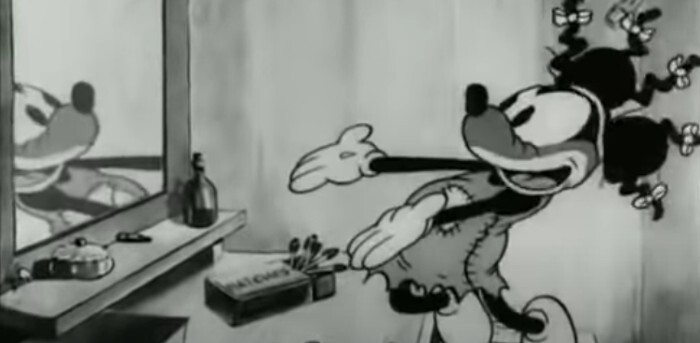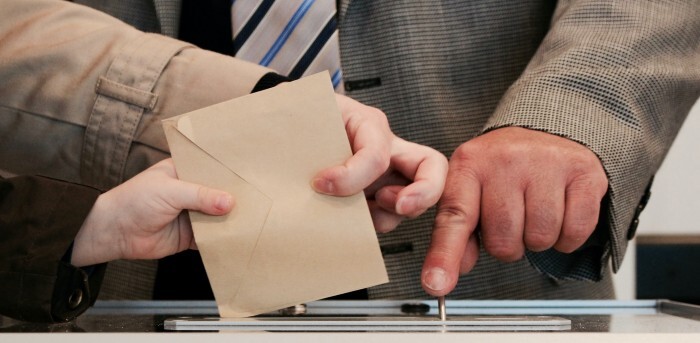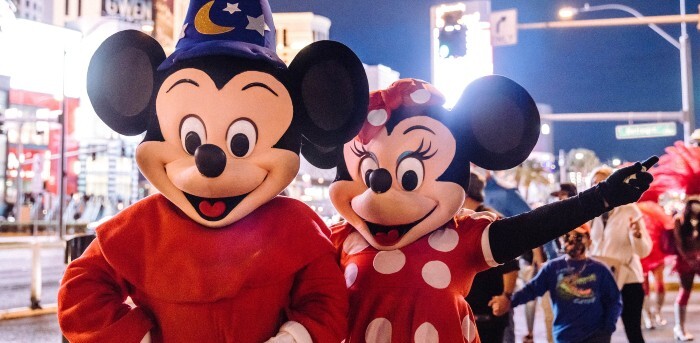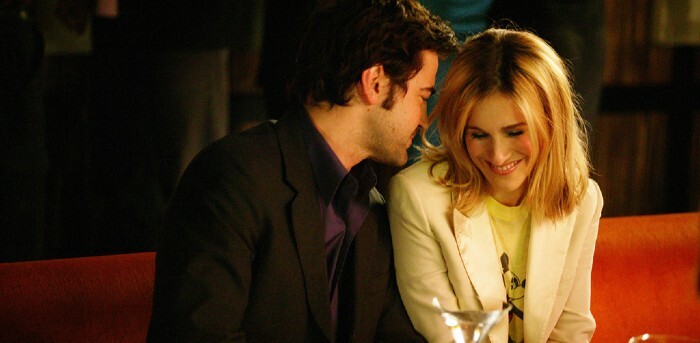The Dark History of Mickey Mouse, Pop Culture's Evilest Rodent

Mickey Mouse has been portrayed as everything from a beacon of innocent whimsy to a literal cartoon villain, but ultimately, he’s the bland symbol of a corporation that doesn’t have any particular motivation beyond making as much money as possible. That doesn’t mean he doesn’t have some seriously messed up dancing skeletons in his closet.
The Real Mickey Mouse

When people asked where the idea for Mickey Mouse came from, Walt Disney liked to tell people about the real mouse that infested his Kansas City studio who he befriended, allowed to live at his desk, fed crumbs from his hands, and named Mortimer before tearfully releasing into a nearby field because he was moving to Hollywood and would no longer be around to protect the little guy from the evil cat who lived downstairs. It sounds like the beginning of one of Disney’s darker films.
He Was Created Out of Revenge

(Universal Pictures)
Walt Disney’s original cash cow was the much less catchy Oswald the Lucky Rabbit, which he created for Universal Pictures in 1927, but after the character proved successful, the studio stole all but one of his employees and threatened to fire Disney unless he took a pay cut. Instead, Disney and his lone loyalist, Ub Iwerks, struck out on their own and, determined to sink that stupid rabbit, reworked their character’s design in the image of Disney’s mouse friend.
Disney’s Wife Changed His Stupid Name
Disney wanted to name his mouse after, well, his mouse, but Mortimer Mouse never would have caught on. It was his wife, according to legend, who convinced him the name was stupid.
Iwerks Never Got the Credit He Deserved
Mickey Mouse was just as much, if not arguably more so, Iwerks’s creation as Disney’s, since Iwerks was the one who actually designed him. He even animated Mickey’s first short all by himself. Disney liked to present himself as the mouse god, though, which pissed Iwerks off so much that he left Disney in 1930 to form his own studio, after which Disney stopped crediting Iwerks at all.
Mickey Wears Blackface

(Walt Disney Company)
Many of his early design characteristics, like his white gloves and heavily outlined facial features, are a little too close to those of minstrel performers for comfort. Oh, he also straight-up did blackface in some cartoons from the late ‘20s and early ‘30s.
Mickey Mouse’s Success Mostly Came Down to Timing

(Walt Disney Company)
Technically, Mickey made his screen debut on May 15, 1928 with the test screening of a silent short called Plane Crazy, but it bombed with the audience. Disney didn’t strike gold until six months later with the premier of Steamboat Willie, which happened to be the first animated film with synchronized music and sound effects. Sound was still a huge cinematic novelty at the time, so despite not really standing out in a sea of cute cartoon characters, Mickey became the Furby of the ‘20s.
Merchandising Mickey

Of course, another major reason Mickey became such a cultural phenomenon was that Disney wasted no time commercializing the shit out of him. Even this can’t really be credited to Disney, though: It all started in 1929, when some rando approached him at a hotel and offered him $300 to put Mickey’s face on a children’s pencil tablet. The tablet was a hit, so people just kept giving Disney money to put his mouse on stuff until another rando approached him with the idea of putting his mouse on all the stuff. To this day, Mickey Mouse merchandise comprises a huge chunk of Disney’s revenue.
Mickey’s Personality Changes With Consumer Demand
Over the years, Mickey has morphed from a belligerent, gay-bashing jerk to a sad sack incel who keeps trying to kill himself after Minnie’s rejections to the bland mascot we know today. Even since then, his character has been tweaked in a careful balancing act of keeping him wholesome enough for children and their money but not so boring that children and their money lose interest. (Donald Duck was actually created because the Disney team was so bored with Mickey, and for a time, he became more popular than the milquetoast mouse.) Basically, he’s a soulless shell that gets injected with whatever traits are most marketable at the time.
Mickey Mouse in Politics

Mickey has been an important political figure since his first decade of existence, when the freaking League of Nations gave Disney a gold medal only because they couldn’t give it to the mouse himself, who they called an “international symbol of goodwill.” His symbolism as a protest vote began even earlier, when one grumpy New Yorker decided they’d rather see him as mayor than anyone else in 1932, and the tradition of writing in “Mickey Mouse” continues to this day. Mickey has even met every president since Harry Truman, except Lyndon B. Johnson, for some reason. He apparently just never went to a Disney park, probably because it was one of the few places he couldn’t whip out his giant hog.
Mickey Mouse as an American Symbol
Proving that Twitter didn’t invent hot takes, Mickey Mouse has been denounced as Everything Wrong With America since 1941, when one historian pointed to his popularity as proof that the country was living “in an intellectual and moral vacuum.” Any time anyone wants to swipe at America, they can do it via Mickey, like when he was banned in Nazi Germany, then in … Communist Germany, then starred in the controversial anti-war parody Mickey Mouse in Vietnam.
The Mickey Mouse Protection Act
Disney is notorious for pushing lawmakers to extend copyright protections every time Mickey Mouse is about to enter the public domain, first in 1976 with the Copyright Act that completely restructured how copyright terms were calculated (based on the death date of the creator rather than a set limit) and then again in 1998 with the Copyright Term Extension Act, which extended protection up to 120 years for corporations. It’s considered such dirty fighting that the latter is known as the Mickey Mouse Protection Act.
Mickey at the Disney Parks

Meeting Mickey is the highlight of many children’s and an uncomfortable number of adults’ lives, but the truth is far less magical than it appears. Because the actor wearing the Mickey suit must be very short, it was likely a miserable teenage girl who has to switch off with a different miserable teenage girl every half hour so she doesn’t die of heat stroke.
Mickey’s Rivals

(Walt Disney Company)
Mickey Mouse has had plenty of competition over the years, and it’s gotten as tense as backstage at a preschool beauty pageant. By introducing sound to animation, he downright murdered Felix the Cat, who was at the peak of his fame the year Steamboat Willie came out but couldn’t handle the crossover to sound. Bugs Bunny has held his own, but when Steven Spielberg wanted both characters in Who Framed Roger Rabbit?, Warner Bros. demanded exactly the same screen time as Mickey. We’re talking down to the frame. They knew what that sneaky mouse would do otherwise.
The Early 2000s Campaign to Sex Up Mickey

(HBO)
Y2K was a confusing time for everyone, but especially the Disney marketing department, who desperately courted the ugly-hat-wearing youth by positioning their mascot in steamy Sex and the City scenes (on the clothes, not, like, under Kim Cattrall), taking Disney fashion to expensive boutiques like Fred Segal, hiring (at least formerly) counterculture graffiti artists to spray paint him on buildings, and begging hot young celebrities to stretch his image across their hot young bosoms. “The idea is that once kids see stars wearing T-shirts featuring the mouse, they will be drawn to all things Mickey,” is an actual sentence from an actual L.A. Times article.
Mickey’s Influence Knows No Bounds

In 2008, Disney claimed their market research showed 98% of all children between the ages of three and eleven were aware of Mickey Mouse. Not all American children or even all English-speaking children -- all children in the world. Basically, if anyone ever needs to propaganda the babies, they know exactly who to (expensively but extremely easily) pay off.
Top image: Evan Fitzer/Unsplash